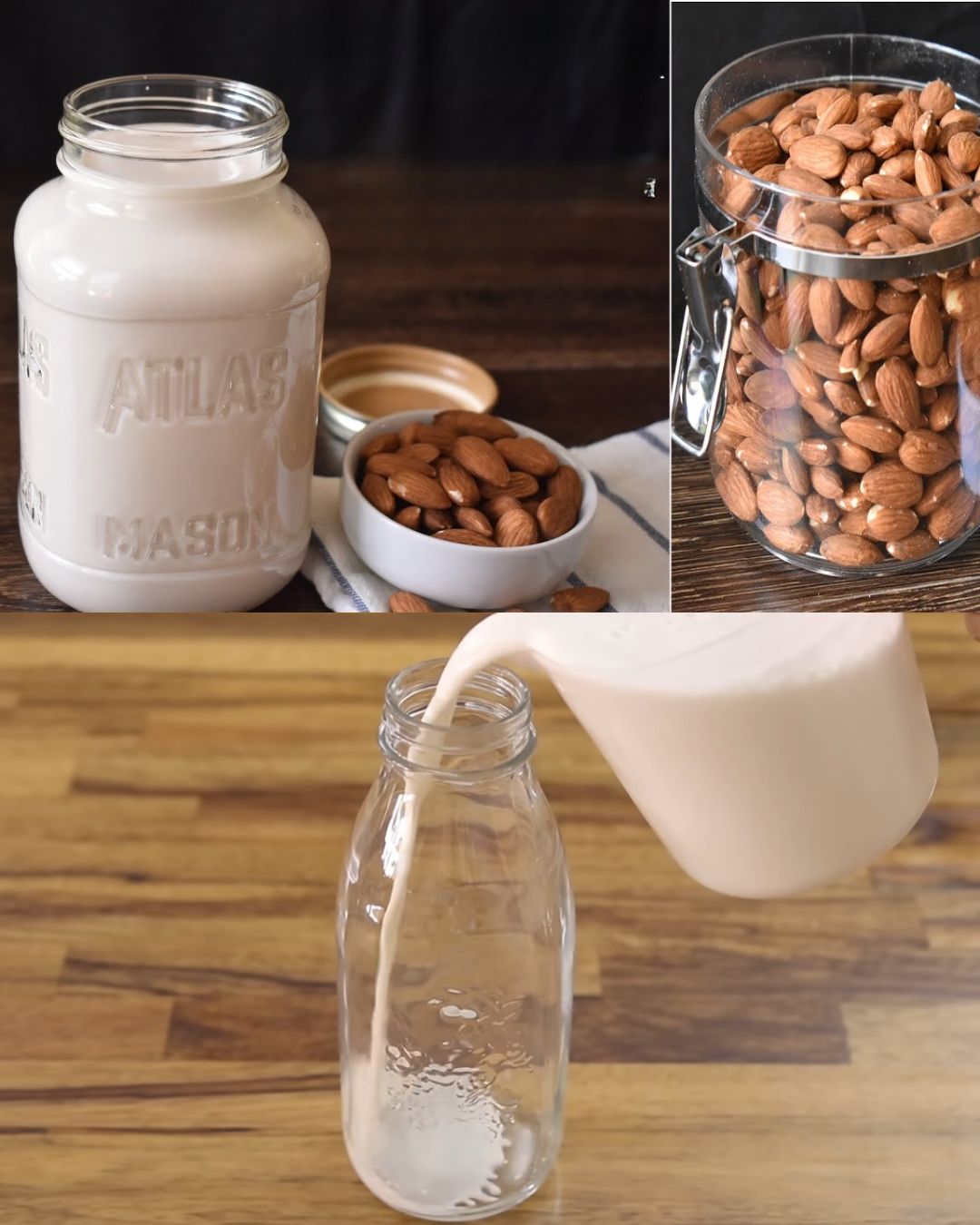Homemade Almond Milk is a creamy and nutritious dairy-free alternative that’s perfect for anyone looking to switch up their milk routine. Made from raw almonds, water, and a touch of vanilla extract, this almond milk is incredibly simple to prepare and offers a smooth, rich flavor that’s perfect for adding to coffee, cereal, smoothies, or simply enjoying on its own.
This recipe ensures that you get the freshest almond milk, free from preservatives and additives often found in store-bought versions. For a slightly sweet twist, consider adding a tablespoon of maple syrup or a pitted Medjool date when blending. The result is a deliciously creamy beverage that’s not only healthy but also versatile and satisfying.
Full Recipe:
Ingredients:
- 1 cup (140g) raw almonds
- 4 cups (1 liter) water
- 1/2 teaspoon vanilla extract
Directions:
- Soak the Almonds:
- Place raw almonds in a large bowl, cover with cold water, and let soak overnight. Drain and rinse the almonds.
- Blend the Almonds:
- Place the soaked almonds in a blender or food processor. Add water and vanilla extract. Blend at the highest speed for 2-3 minutes, until the mixture looks smooth and creamy.
- Strain the Almond Milk:
- Strain the almond milk through a nut-milk bag or cheesecloth, squeezing well to extract the extra liquid.
- Store the Almond Milk:
- Pour the milk into an airtight container. Store in the fridge for up to 4 days.
Notes:
- For a sweet version, you can add 1 tablespoon of maple syrup or one pitted Medjool date when blending.
Prep Time: 10 minutes | Total Time: 10 minutes + soaking time
Kcal: 60 kcal per cup | Servings: Makes about 4 cups
Here are some additional tips and information about this recipe:
Tips for Making the Best Homemade Almond Milk
- Soaking Time: For the creamiest almond milk, soak the almonds overnight or for at least 8 hours.
- Straining: Use a nut-milk bag or fine cheesecloth to ensure a smooth consistency.
- Sweetening: Add natural sweeteners like maple syrup, honey, or dates for a hint of sweetness.
Variations and Serving Suggestions
- Flavored Almond Milk: Add cocoa powder for chocolate almond milk or a pinch of cinnamon for a spiced version.
- Serving Ideas: Enjoy with granola, in coffee, or use it as a base for smoothies and shakes.
- Storage Tips: Shake well before each use as natural separation may occur.
Storage Tips
- Refrigeration: Store in an airtight container in the refrigerator for up to 4 days. Shake well before use.
- Freezing: Homemade almond milk can be frozen in ice cube trays and used in smoothies.
Nutritional Information
Here’s a brief look at the nutritional content per cup (approximate values):
Advertisement
- Calories: 60 kcal per cup
- Carbohydrates: 2g
- Protein: 2g
- Fat: 5g
- Saturated Fat: 0.5g
- Cholesterol: 0mg
- Fiber: 1g
- Sugar: 1g
Possible Questions About This Recipe
- Can I use other nuts instead of almonds?
- Yes, you can use cashews, hazelnuts, or walnuts following the same process.
- What if I don’t have a nut-milk bag?
- Use a fine mesh strainer lined with cheesecloth or a clean kitchen towel.
- How do I use the leftover almond pulp?
- The leftover pulp can be used in baking, added to smoothies, or dried and used as almond flour.
- Can I skip the soaking step?
- Soaking is essential for a creamy texture and easier blending. If in a rush, a quick soak in hot water for 1-2 hours can work.
- Is homemade almond milk cheaper than store-bought?
- Homemade almond milk can be more cost-effective, especially if you buy almonds in bulk.
- Can I use flavored extracts other than vanilla?
- Yes, almond extract or other flavors can be used for variety.
- How can I make the almond milk thicker?
- Reduce the amount of water for a thicker consistency.
- What’s the best way to blend the almonds?
- Use a high-speed blender for the smoothest results.
- Is it necessary to peel the almonds?
- Peeling is optional, but it can result in a smoother milk. Most prefer to leave the skins on.
- How do I know if the almond milk has gone bad?
- Homemade almond milk will typically last up to 4 days. If it smells sour or has an off taste, it’s best to discard it.
Conclusion
For those interested in reducing waste, the leftover almond pulp can be repurposed in a variety of ways. It can be dried and used as almond flour, added to smoothies for extra fiber, or incorporated into baking recipes. This ensures that you’re getting the most out of your ingredients and contributing to a more sustainable kitchen practice.
In conclusion, making your own almond milk at home is a rewarding and simple process that results in a delicious and versatile product. Whether you enjoy it plain, sweetened, or flavored, homemade almond milk is a delightful way to enhance your diet with wholesome, plant-based goodness. Soak, blend, strain, and savor the benefits of this creamy, nutritious drink. Cheers to homemade almond milk and the joy of creating something delicious from scratch!

